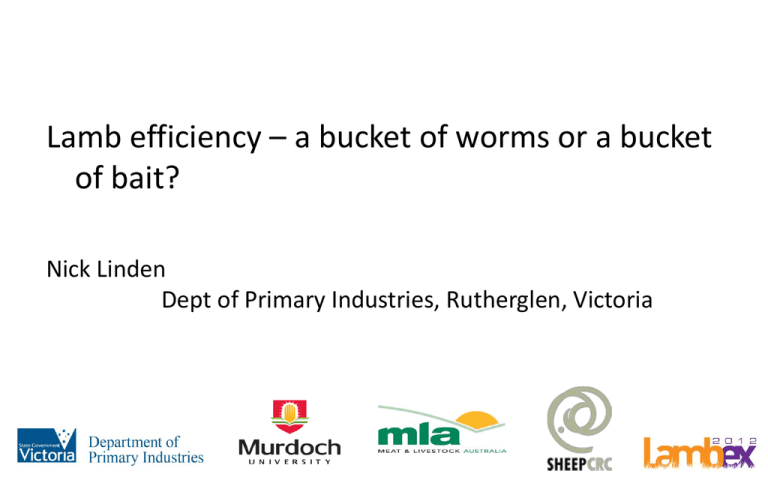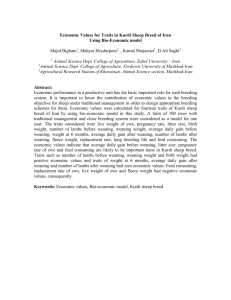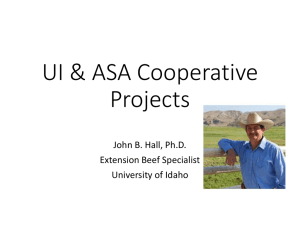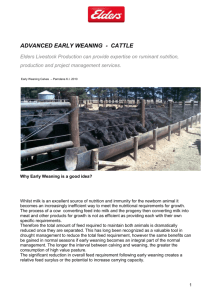
Lamb efficiency – a bucket of worms or a bucket
of bait?
Nick Linden
Dept of Primary Industries, Rutherglen, Victoria
Outline
• 1) Background and methods
• 2) On-farm factors
– Growth path (pre-weaning restriction)
– Weaning weight and age at finishing
• 3) Can we improve efficiency - benefits/risks?
Acknowledgements
•
•
•
•
Dr Alex Ball – MLA
Tom Bull - Lambpro
Dr Daniel Brown – AGBU
Dr Graham Gardner – Murdoch Uni/Sheep
CRC
Lamb or lederhosen, profit is still profit…
Profit = kg’s sold x (Unit price – Cost Of Prod.)
C.O.P driven by business efficiency
Inputs
Outputs
Variation in feed conversion
20
15
kg's gain
10
5
0
-5
0.0
20.0
40.0
60.0
-10
-15
kg's intake
80.0
100.0
My starting point
Measuring feed intake
Temp and humidity
every 15 mins
Impact of a pre-weaning restriction
Finishing
36.5
16
13.2
Birth to weaning
29.2
Backgrounding
Impact of a pre weaning restriction
Finishing
47
36.5
40
16
13.2
Birth to weaning
29.2
Backgrounding
Impact of a pre weaning restriction
Finishing
55, FCR 7.4
47
49, FCR 7.8
36.5
40
16
13.2
Birth to weaning
29.2
Backgrounding
Pre-weaning restriction – older lambs
Finishing
48
42
Birth to weaning
Backgrounding
53, FCR 16
47, FCR 17.2
Weaning weight v’s age at finishing
Light
(24-27kg)
21 weeks
29 weeks
38 weeks
Medium
(28-31kg)
Heavy
(32-35kg)
Wt gain - three weaning wt and ages
0.31
21 weeks
29 weeks
38 weeks
0.29
Daily wt gain (kg)
0.27
0.25
0.23
0.21
0.19
0.17
0.15
Light
Medium
Heavy
Feed intake - three weaning wt and ages
1.8
1.7
21 weeks
29 weeks
38 weeks
Daily feed inake (kg)
1.6
1.5
1.4
1.3
1.2
1.1
1
0.9
Light
Medium
Heavy
FCR - three weaning wt and ages
8
21 weeks
29 weeks
38 weeks
Feed Conversion Ratio (x:1)
7.5
7
6.5
6
5.5
5
4.5
4
Light
Medium
Heavy
FCR – sex at 3 ages
8
Feed Conversion Ratio (x:1)
7.5
Ewes
Wethers
7
6.5
6
5.5
5
4.5
4
21 weeks
29 weeks
38 weeks
What does it mean for industry
•
Most efficient lambs put on 1kg live weight for every 3 kg of feed consumed.
– Cost to finish $6.39
•
Least efficient lambs eat 15+kg of feed, for every 1kg of live weight gain.
– Cost to finish in the order of $30.00 (in feed costs alone)
•
Variation between sire groups for FCR ranged from 5.17 to 8.81, average for all
lambs, 7.09:1
ITS WORTH DOING SOMETHING ABOUT IT!!!!!
How can we capture benefits?
• Correlations of 0.8 and 0.4 – genomic breeding
values v’s milk yield and v’s feed efficiency traits.
• We know what pigs and poultry have achieved.
• If feeding lambs at home, there are tools.
Industry implications
•
Restricted growth through to weaning does not compromise the efficiency of lambs
when it comes time to finish them.
– Lambs that are light at weaning can still be finished in a cost effective manner,
HOWEVER if carrying lambs over, beware of lambs that were already heavy.
•
Lambs that are light at weaning do have a bigger ‘window’ for finishing – still efficient
at older ages.
•
Inefficiency driven by two things – poor weight gains and they still consume a heap of
feed (lambs that are heavy at weaning, but hung onto too long!)
•
Feeding lambs at the ‘right’ stage of maturity appears to be critical to profitable
outcomes – don’t try and turn them into something they shouldn’t be!
We love our lamb!
Pre-weaning restriction
- 40kg
600
Finishing
Live weight
30 mths
400
200 Pre-weaning
Grow-out
- 35kg
220
- 70kg
•
•
•
•
some compensation during backgrounding
similar feedlot growth performance
calves don’t catch up in weight
no adverse effect on composition
Age
Low birth weight
600
Finishing
- 55kg
Live weight
30 mths
400
200 Pre-weaning
Birth
- 10kg
Grow-out
- 25kg
•
•
•
•
•
Age
- 40kg
slower growth to weaning
no compensation during backgrounding
reduced feedlot performance
calves don’t catch up in weight
no adverse effect on composition








